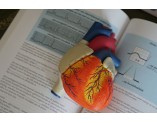Arthritis
There are many types of arthritis that affect millions of Americans every day, not just the kind that makes us think of painful, stiff joints. Each type of arthritis has different symptoms, but most types are chronic.
Arthritis can affect joints in almost any part of the body. Some types of arthritis cause changes you may notice and feel, such as swelling, warmth and redness of joints. In other types of arthritis, the pain and swelling last only a brief period of time, but are very uncomfortable.
What is arthritis?
According to the US National Library of Medicine, “if you have trouble moving around or feel pain and stiffness in your body, you could have arthritis. In the most common cases, arthritis causes pain and swelling in the joints”.
Eventually a swollen and inflamed joint can suffer serious damage. In some cases, arthritis can cause problems in the patient's eyes, skin or other organs.
Statistics show that approximately 1 in every 5 American adults has a form of diagnosed arthritis. As the country's population ages, it is estimated that this number will increase to at least 67 percent by 2030.
Arthritis is not a solitary disease - it is a term that covers over 100 different medical conditions. Osteoarthritis (OA) is the most common form of arthritis and generally affects elderly patients.
Common types of arthritis
Arthritis is one of the most common diseases in the United States. Older people most often suffer from osteoarthritis, rheumatoid arthritis or gout.
Osteoarthritis (OA) is the most common type of arthritis in elderly people. OA starts when tissue, called cartilage, that pads bones in a joint begins to deteriorate. When the cartilage has eroded, your bones rub against each other. OA most frequently happens in your hands, neck, lower back or the larger joints of your body, such as knees and hips.
OA symptoms range from stiffness and mild discomfort that comes and goes to continuous pain. Occasionally OA causes your joints to feel stiff after you haven't moved them for a while, like after sitting for long periods of time. The stiffness goes away when you move the joint around. Over time, OA can make it difficult to move your joints and can cause you to become disabled if your back, knees, or hips are affected.
Aging is what most often puts you at risk for OA, possibly because your joints and the cartilage around them become less able to recuperate after stress and damage. In addition, OA in the hands may be hereditary or in the knees can be connected to obesity. Injuries or continuous use may cause OA in joints such as knees, hips or hands.
Rheumatoid arthritis (RA) is an autoimmune disease that makes your body attack itself. RA causes pain, inflammation, and rigidity that lasts for hours. RA can occur in many different joints at the same time. People with RA often feel fatigued or may run a fever and is more common in women than men.
RA can damage almost any joint and frequently happens in the same joint on both sides of your body. RA can also cause problems with your muscles, nervous system, blood vessels, heart and eyes.
Gout is an exceedingly painful inflammation of the joints caused by an accumulation of needle-like uric-acid crystals.
The big toe is the most common focus, but gout can attack the feet, ankles, knees and hands as well.
An attack or “flare up” can last for days or months. Men and obese people are at a higher risk. If you’re prone to gout, the foods you eat, and don’t eat, play an important role in keeping your joints pain-free. Avoiding foods high in purines can help, the following is a list of foods to avoid:
- Beer and other alcoholic beverages
- Organ meats, such as liver, kidney, heart and gizzard
- Poultry, especially goose
- Red meat
- Seafood
- Sweetbread, a food made from animal glands
- Wild game
- Asparagus
- Cauliflower
- Dried beans and lentils
- Green peas
- Mushrooms
- Spinach
Signs and symptoms of arthritis
Some of the early signs and symptoms of arthritis are usually ignored by individuals who blame their symptoms on “getting old”. Although arthritis is not a curable disorder, it is important to get a diagnosis early so the person can obtain the appropriate treatment and hopefully prevent additional joint damage. Signs that indicate you may have arthritis include:
- Early morning stiffness
- Joint swelling in at least one place but can be multiple places
- Loss of joint flexibility
- Redness, inflammation, warmth, tenderness or pain in any joint
- Fever, weakness and/or unexplained weight loss may also accompany these symptoms
Caring for those with arthritis
Arthritis can be painful and challenging for people to deal with so family members should know how to assist those suffering from arthritis so that they can help their loved ones when needed. Knowing about the different forms of arthritis can also be very useful for family caregivers so that they know exactly what to anticipate when caring for their loved ones.
Medications
Medications are the most beneficial way to manage arthritis, but many seniors forget to take their medication consistently or only take it when their pain gets out of control. Family members or caregivers should make certain that they are familiar with the person’s medication so that they can make sure they are taking it as prescribed.
Many seniors suffering from arthritis have difficulty opening their medication because of their joint pain so it can be helpful for family member or caregivers to put the medication into an easy open container. Cold packs or heat packs are also very helpful for alleviating joint pain from arthritis. Family members and caregivers can provide cold packs keep a supply of heat packs to deliver much needed relief when necessary.
Muscle strengthening
Muscle strengthening around arthritic joints is another way to help ease pain. Many physicians and physical therapists can recommend exercises that family members or caregivers can help their loved ones complete at home on a consistent basis that will strengthen their muscles and make it easier to move the joints.
Exercise Plan
Another thing to take into account when dealing with arthritis is diet and exercise. It is important for people suffering from arthritis to be aware of their weight. Being overweight can worsen arthritis symptoms since the added weight puts more strain on the muscles and joints.
Accessibility
Another helpful tip that family members and caregivers can be aware of is accessibility. Having a pair of scissors close by for opening packages can be very helpful for those with arthritis pain and inflammation. Electric can openers and tools for opening jars are also beneficial, especially for those who live by themselves.
Family members, in-home caregivers and long term facility staff can assist their residents in managing their arthritis by following some simple tips and communicating with their doctor. Family and caregivers should be aware that joint pain and inflammation can make even the simplest daily tasks difficult and should be patient and supportive when caring for their loved ones. Family members that are still having difficulty caring for their loved ones can speak with their physician for additional information or consider a homecare service provider or a long term care facility such as residential care homes, assisted living facilities or nursing homes that are trained in this area.
Searching for the right long-term care facility is important for a patient’s continued quality of life. The need for assistance when suffering from a debilitating condition such as arthritis is crucial not only for the prevention of accidents and injuries, but for the safety and wellbeing of the patient.









